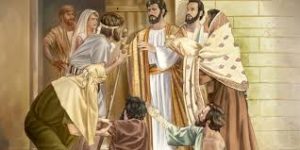Jesus’ Headquarters in Capernaum
Matthew 4: 13-16

As a result of His rejection in Nazareth, Jesus made His headquarters in Capernaum, just down the hill from Nazareth. Leaving Nazareth, He went and lived in Capernaum, which was by the lake in the area of Zebulun and Naphtali (Matthew 4:13). The Sea of Galilee (Matthew 4:15, 18, 15:29; Mark 1:16, 7:31, which was really a very large lake, was sometimes called Tiberias (John 6:1 and 23).
For more than two centuries, the business of fishing defined the bustling town of Capernaum on the Sea of Galilee, as boats and nets lined every inch between the stone piers and the breakwater. Some were ferries, designed to carry passengers quickly and easily down to Magdala, or across the eight miles of sea to Gergesa. But, most boats were for fishing. Of more than a dozen major fishing villages on the shores of Lake Gennesaret, as the freshwater sea is also known, none is busier than Capernaum, not even Herod Antipas’ creation of Tiberias city. A detachment of one hundred Roman soldiers had been posted there to ensure that all the taxes were collected according to Roman law.388 On a major highway on the north shore of Galilee it provided constant traffic for the Good News to spread all over the region.
To fulfill what was said through the prophet Isaiah (Matthew 4:14): “Land of Zebulun and land of Naphtali, the Way of the Sea, beyond the Jordan (see my commentary on Isaiah, to see link click Cj – He Will Honor Galilee of the Gentiles).
Galilee of the Gentiles (Matthew 4:15) is a name reflects the historical experience of the region, which was the territory of some of the tribes of the northern kingdom of Israel. It was an area of disgusting idolatry and paganism, especially in the tribe of Dan to the north. In 722 BC the Assyrians conquered the area, sending the Israelites to Assyria or intermarrying with them in the Land. Eventually the region became a mixture of Jews, Assyrians, and Jews who married Assyrians who later became known as the Samaritans.
As a result, Galilee was a land of darkness for many centuries. Nevertheless, in a rather strange prophecy, it is this Galilee of the Gentiles (not religious Jerusalem) where a great light will pierce the darkness of history. The people living in darkness have seen a great light; on those living in the land of the shadow of death a light has dawned” (Mattityahu 4:16).
What Isaiah predicted in his generation was affirmed in rabbinic tradition many times with the hope of the coming Meshiach. In the mystical literature of the Zohar, some of the rabbis even saw a logical reason for this promise of Isaiah. The rabbis taught that “the Messiah will arise and reveal Himself in the Land of Galilee because that [will be] the first place to be destroyed in the Holy Land” (Zohar 2:7b). Matthew’s point is that Yeshua will fulfill even the minute details concerning the promised Messiah as spoken in the TaNaKh.389



Leave A Comment